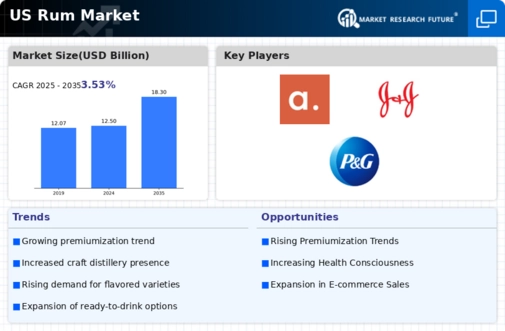Expansion of E-commerce Channels
The rum market is witnessing a significant transformation due to the expansion of e-commerce channels. Online sales of alcoholic beverages have increased dramatically, with estimates suggesting a growth rate of 15% annually. This shift allows consumers to access a wider variety of rum brands and products from the comfort of their homes. E-commerce platforms are also facilitating direct-to-consumer sales, enabling brands to build stronger relationships with their customers. As a result, the rum market is likely to see an increase in brand loyalty and repeat purchases. Furthermore, the convenience of online shopping is appealing to younger demographics, who are becoming increasingly influential in the market. This trend may lead to a more competitive landscape as traditional retailers adapt to the changing consumer behavior.
Health-Conscious Consumer Trends
The rum market is increasingly influenced by health-conscious consumer trends, as individuals become more aware of their dietary choices. This shift is prompting brands to develop lower-calorie and organic rum options, catering to a demographic that prioritizes health without sacrificing taste. Recent surveys indicate that approximately 40% of consumers are actively seeking healthier alcoholic beverage options. This trend is likely to drive innovation within the rum market, as producers explore new formulations and ingredients that align with health trends. Additionally, the rise of wellness-focused bars and restaurants is creating new opportunities for rum brands to position themselves as part of a balanced lifestyle, potentially expanding their consumer base.
Influence of Social Media Marketing
Social media marketing is playing a pivotal role in shaping the rum market, as brands leverage platforms like Instagram and TikTok to engage with consumers. The visual nature of these platforms allows rum brands to showcase their products creatively, often leading to viral trends that can significantly boost sales. Recent data indicates that brands utilizing social media effectively have seen sales increases of up to 25%. This trend is particularly impactful among younger consumers, who are more likely to discover new products through social media influencers. As the rum market continues to evolve, the importance of digital marketing strategies will likely grow, compelling brands to invest in innovative campaigns that resonate with their target audiences.
Emergence of Innovative Flavor Profiles
The rum market is characterized by the emergence of innovative flavor profiles, as brands experiment with unique ingredients and production techniques. This trend is driven by consumers' desire for novel experiences and diverse taste options. Recent market analysis suggests that flavored rums are gaining popularity, with sales increasing by approximately 18% over the last year. This diversification not only attracts adventurous consumers but also encourages traditional rum producers to adapt and innovate. As the market evolves, the introduction of exotic flavors and limited-edition releases may become a key strategy for brands aiming to differentiate themselves. This dynamic could lead to a more vibrant and competitive rum market, appealing to a broader audience.
Growing Consumer Interest in Craft Spirits
The rum market in the US is experiencing a notable shift towards craft spirits, driven by consumers' increasing preference for artisanal and locally produced beverages. This trend is reflected in the rising number of craft distilleries, which have surged by approximately 20% over the past five years. As consumers seek unique flavors and authentic experiences, craft rum brands are gaining traction, contributing to a more diverse market landscape. The craft segment is projected to account for a larger share of the rum market, potentially reaching 30% by 2026. This growing interest in craft spirits not only enhances consumer engagement but also encourages innovation within the industry, as distillers experiment with various ingredients and production methods to cater to evolving tastes.














Leave a Comment